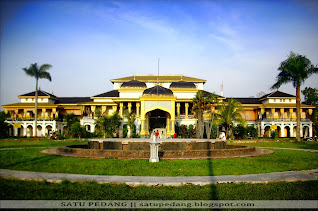The History of the Origins of the Maimun Palace in North Sumatra
Selasa, 10 Januari 2023
This palace is dominated by yellow, the color of the greatness of the Malay kingdom. Construction of the palace was completed on August 25, 1888 AD, during the reign of Sultan Makmun al-Rasyid Perkasa Alamsyah . Sultan Makmun is the eldest son of Sultan Mahmud Perkasa Alam , the founder of the city of Medan.
1. History
Since 1946, this palace has been inhabited by the heirs of the Sultanate of Deli . At certain times, traditional Malay music performances are often held at this palace. Usually, these shows are held in order to enliven weddings and other joyous activities. In addition, twice a year, the Sultan of Deli usually held a friendly event between the royal family. On every Friday night, the sultan's family holds a traditional care event (a kind of family wiridan ).
For visitors who come to the palace, they can still browse the collections on display in the meeting room, such as photographs of the sultan's family, old Dutch household furniture, and various types of weapons. Here, there is also a stump cannon which has its own legend. The Medanese call this cannon a butt cannon .
The story of this butt cannon has a connection with Putri Hijau . It is said, in the Greater Eastern Kingdom, there lived a beautiful princess, named Putri Hijau. He is called so, because his body emits a green color. He has two brothers, namely Mambang Yasid and Mambang Khayali . Once upon a time, the King of Aceh came to propose to Putri Hijau , however, this proposal was rejected by his two brothers. The King of Aceh became angry, then attacked the Timur Raya Kingdom. The King of Aceh succeeded in defeating Mambang Yasid. When the Acehnese soldiers were about to enter the palace to kidnap Putri Hijau, a miracle suddenly happened, Mambang Khayali suddenly turned into a cannon and fired indiscriminately without stopping. Because it continuously fired bullets at the Acehnese troops, this cannon was split in two. The front is found in the Surbakti area, on the Karo plateau, near Kabanjahe. While the back was thrown into Labuhan Deli, then
moved to the courtyard of the Maimun Palace. Every day, the palace is open to the public, unless there is a special ceremony.
2. Location
This palace is located on Jalan Brigadier General Katamso, Sukaraja sub-district, Medan Maimun sub-district, Medan, North Sumatra .
3. Spacious
The area of the palace is approximately 2,772 m, with a courtyard that covers 4 hectares. The length from front to back reaches 75.50 m. and the building height reaches 14.14 m. The two-story palace building was supported by wooden pillars and stones. Every afternoon, usually a lot of children who play in the vast courtyard of the palace.
4. Architecture
The architecture of the building is a blend of Moghul, Middle Eastern, Spanish, Indian, Dutch and Malay architectural features. The influence of Dutch architecture can be seen in the wide and tall forms of doors and windows. However, there are several doors that show Spanish influence. Islamic influence can be seen in the existence of arches ( arcades ) on the roof. The height of the arch ranges from 5 to 8 meters. This arch shape is very popular in the Middle East, India and Turkey.
The palace building consists of three main rooms, namely: the main building, the right wing and the left wing. The main building is also called the Balairung with an area of 412 m 2 , where the royal throne is located. The royal throne is used on certain occasions, such as the coronation of a king, or when receiving worship from the royal family on Islamic holidays. In this building there is also a large European-style crystal chandelier. Inside the palace there are 30 rooms, with different interior designs. unique, a mix of art from various countries. From the outside, this palace facing east looks like the palace of the Moghul kings.
5. Planner
There are several opinions about who actually designed this palace. Some sources say the designer was an Italian architect, but the exact name is not known. Another source, namely the tour guide on duty at this palace, revealed that the architect was a Dutch captain named TH Van Erp .
6. Renovation
This palace seems unkempt, perhaps, this is due to the lack of funds owned by the sultan's family. During this time, maintenance costs are highly dependent on the donations of visitors who come. To make it look more beautiful, renovations should have been carried out, of course with the help of all parties concerned with the fate of the nation's cultural heritage.
Maimun Palace has been named the most beautiful building in Medan City, North Sumatra. Located in the area of Jl. Brigadier General Katamso, this magnificent palace was completed around 1888 and is a legacy from the Sultan of Deli Makmun Al Rasyid Perkasa Alamsyah . The yellow wash on this building is a typical Malay color.


